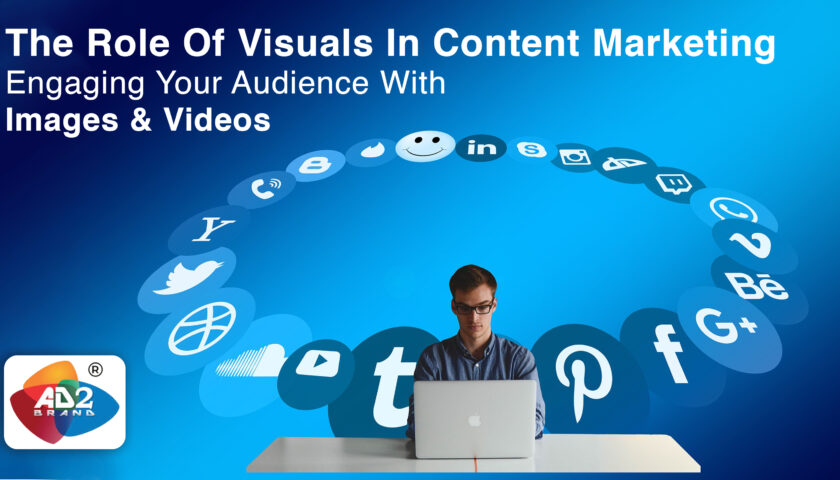Introduction:
In today\’s digital age, content marketing has become an indispensable tool for businesses to reach and engage their target audience effectively. To stand out in the competitive online landscape, marketers must utilize various elements to capture the attention of their audience. One such powerful element is visuals – images and videos that can elevate the impact of your content and leave a lasting impression on your audience. In this comprehensive article, we will delve into the role of visuals in content marketing and explore how they can engage your audience, boost your brand\’s presence, and drive better results.
Visuals have a pivotal role in content marketing. They go beyond mere aesthetics and play a significant role in captivating the audience\’s attention, conveying complex ideas, and evoking emotions. Let\’s explore the multifaceted aspects of visuals and their impact on content marketing.
1. Capturing Attention with Striking Visuals
In the vast ocean of digital content, catching your audience\’s attention within seconds is crucial. Striking visuals act as magnetic forces that draw the eyes of viewers, making them more likely to stay and engage with your content.
2. Enhancing Content Readability and Comprehension
Visuals, when used strategically, can aid in breaking down complex information into digestible pieces. Infographics, for example, help present data and statistics in an easily understandable manner, improving content readability and enhancing overall comprehension.
3. Eliciting Emotions and Building Connections
Emotions play a vital role in shaping consumer behavior. Images and videos have the power to evoke emotions, making your content more relatable and building a stronger connection with your audience.
4. Boosting Social Media Engagement
In the era of social media dominance, incorporating visually appealing content can significantly boost engagement on platforms like Facebook, Instagram, and Twitter. Shareable images and videos have higher chances of going viral, expanding your content\’s reach organically.
5. Increasing Dwell Time and Lowering Bounce Rates
When visitors are met with an engaging visual experience, they are more likely to spend more time on your website. This increased dwell time can lead to lower bounce rates, signaling search engines that your content is valuable and relevant to users.
6. Strengthening Brand Identity
Consistent use of visuals that align with your brand\’s identity helps reinforce brand recognition. When users encounter familiar images and videos associated with your brand, they develop a sense of trust and reliability.
7. Catering to Different Learning Styles
Not all audiences consume information the same way. Visual content caters to diverse learning styles, ensuring your message reaches a broader audience and resonates with them effectively.
8. Boosting SEO and Organic Visibility
Search engines consider user engagement metrics, such as time on page and bounce rates, while ranking content. Well-optimized visuals can improve these metrics, positively impacting your SEO efforts and organic visibility.
9. Leveraging User-Generated Content
User-generated visuals, such as customer reviews, photos, and videos, can act as powerful social proof. They demonstrate authentic experiences, building trust and credibility among potential customers.
10. Tapping into the Power of Videos
Videos have emerged as one of the most engaging forms of content. Whether it\’s product demonstrations, tutorials, or brand stories, videos have the ability to convey complex messages in an engaging and memorable way.
11. Incorporating Visuals into Email Marketing
Email marketing campaigns that include visually appealing elements garner higher open rates and click-through rates. By using images and videos in emails, you can pique the curiosity of your subscribers and encourage them to take action.
12. Addressing Accessibility and Inclusivity
When using visuals, it\’s essential to ensure they are accessible to all users, including those with visual impairments. Providing alt text for images and captions for videos ensures inclusivity and improves user experience for all.
13. Analyzing Visual Content Performance
Utilize data and analytics to measure the effectiveness of your visual content. Track engagement metrics, conversion rates, and other relevant data to refine your visual marketing strategy continually.
14. A/B Testing Visual Elements
To optimize your content\’s performance, conduct A/B tests with different visual elements. Test various images, video formats, and placements to identify what resonates best with your audience.
15. Creating Interactive Visual Experiences
Interactive visuals, such as quizzes, polls, and interactive infographics, provide an immersive experience for your audience. They encourage active participation, driving higher engagement rates.
16. The Impact of Color Psychology in Visuals
Colors evoke emotions and influence consumer behavior. Understand color psychology and use it to your advantage when selecting visuals for your content.
17. Collaborating with Influencers and Visual Content Creators
Partnering with influencers and content creators who excel in visual storytelling can amplify your brand\’s message and extend your reach to new audiences.
18. Optimizing Visuals for Mobile Devices
Given the prevalence of mobile device usage, it\’s essential to ensure that your visuals are optimized for various screen sizes, offering a seamless experience across all devices.
19. Protecting Visuals with Watermarks and Copyrights
If you create original visual content, protect your intellectual property with watermarks and copyright registrations to prevent unauthorized use.
20. Leveraging Augmented Reality (AR) and Virtual Reality (VR)
Explore the innovative world of AR and VR to create immersive experiences that captivate and engage your audience on a whole new level.
21. Balancing Visuals and Textual Content
While visuals are powerful, striking the right balance between visuals and textual content is essential. Avoid overwhelming your audience with an excessive amount of imagery, ensuring that both elements complement each other.
22. Storytelling through Visuals
Effective storytelling through visuals can leave a lasting impact on your audience\’s minds. Craft narratives that align with your brand\’s values and resonate with your target audience.
23. Utilizing User Experience (UX) Design Principles
Apply UX design principles to optimize the user experience when interacting with your visual content. Seamless navigation and intuitive interfaces can significantly enhance engagement.
24. Repurposing Visual Content
Maximize the value of your visual assets by repurposing them across different platforms and marketing campaigns, saving time and resources while maintaining consistency.
25. Future Trends in Visual Content Marketing
Stay ahead of the curve by keeping an eye on emerging trends in visual content marketing. From AI-generated visuals to immersive 3D experiences, anticipate what lies ahead to create cutting-edge campaigns.
FAQs
Q: Why are visuals important in content marketing?
Visuals are important in content marketing because they grab the audience\’s attention, enhance readability, and elicit emotions, leading to higher engagement and improved brand recognition.
Q: How can I use visuals to improve my social media presence?
To improve your social media presence, create shareable images and videos that resonate with your target audience and encourage them to interact with your content.
Q: What types of visuals perform best in email marketing campaigns?
Visuals that perform best in email marketing campaigns include eye-catching images, GIFs, and embedded videos that compel subscribers to open and engage with your emails.
Q: How can I ensure my visual content is accessible to all users?
To ensure accessibility, provide alt text for images and captions for videos, making your visual content inclusive and available to users with visual impairments.
Q: What metrics should I track to measure the effectiveness of my visual content?
Track metrics such as engagement rates, conversion rates, time on page, and bounce rates to measure the effectiveness of your visual content.
Q: How can I protect my original visual content from unauthorized use?
Protect your visual content with watermarks and copyright registrations to prevent unauthorized use and safeguard your intellectual property.
Conclusion:
In today\’s digital landscape, visuals have proven to be an indispensable tool for successful content marketing strategies. As we\’ve explored throughout this comprehensive article, visuals play a multifaceted role in engaging audiences, boosting brand presence, and driving better results.
Captivating attention with striking visuals is crucial in a world where attention spans are short and competition for audience engagement is fierce. By incorporating eye-catching images and videos, businesses can entice viewers to stay and interact with their content.
Visuals also enhance content readability and comprehension by presenting complex information in easily digestible formats like infographics. They tap into the power of emotions, building connections with the audience and strengthening brand identity.
In the realm of social media, visually appealing content is highly shareable and can significantly boost engagement on platforms like Facebook, Instagram, and Twitter. Additionally, visuals positively impact SEO efforts, increase dwell time on websites, and lower bounce rates, signaling search engines that the content is valuable to users.
To be truly effective, visual content must also address accessibility and inclusivity concerns. Providing alt text for images and captions for videos ensures that all users can access and enjoy the content.
Analyzing visual content performance through data and A/B testing helps marketers refine their strategies continually. Leveraging the power of colors, interactive experiences, storytelling, UX design principles, and the innovative world of AR and VR can further elevate the impact of visual content.
As we look to the future, staying ahead of emerging trends in visual content marketing, such as AI-generated visuals and immersive 3D experiences, will be crucial for creating cutting-edge campaigns.
To implement a successful visual content marketing strategy and stay ahead in the dynamic digital landscape, businesses can partner with experts like Ad2Brand marketing agency. With their expertise in visual storytelling and digital marketing, Ad2Brand can help businesses craft compelling campaigns that engage audiences, elevate brand presence, and drive measurable results.
In conclusion, visuals are an essential element of content marketing, and leveraging their power strategically can significantly enhance the success of marketing efforts in the digital age. So, embrace the potential of visuals and embark on a journey to create impactful and memorable content experiences for your audience.




